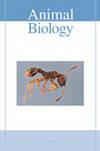Correlated evolution between herbivory and gastrointestinal tract in a prolific lizard adaptive radiation
IF 0.9
4区 生物学
Q2 ZOOLOGY
引用次数: 2
Abstract
Radiations of ectothermic vertebrates across cold climates depend on the coordinated evolution of multiple traits that compensate for the constraints imposed by limited and fluctuating resources, such as temperature, food and oxygen. One of nature’s most prolific such radiations, Liolaemus lizards, has diversified across the extreme cold climates of the Andes and Patagonia. Remarkably, the prevailing patterns of reptile herbivory are opposed by Liolaemus which, in contrast with lizards generally, have repeatedly evolved plant consumption across small-bodied species from cold climates. Herbivory is hypothesized to depend on the evolution of multiple traits that maximize absorption of nutrients from an intrinsically poor-quality diet, such as increases in gastrointestinal tract size and increases in the density of nematodes in the intestine that may assist with plant digestion. Here, a comparative phylogenetic approach across Liolaemus species is implemented to test these hypotheses, which have only been investigated nonphylogenetically. Results reveal that intestine length increases consistently with increasing herbivory, whereas stomach size or nematode load are not associated with plant consumption. Body size plays no role in herbivory either. Consequently, this evidence places emphasis on the enlargement of the intestine to facilitate the evolution of herbivory in cold climates.繁殖蜥蜴的食草性与胃肠道的相关进化
外热脊椎动物在寒冷气候中的辐射取决于多种特征的协调进化,这些特征弥补了有限和波动的资源(如温度、食物和氧气)带来的限制。Liolaemus蜥蜴是自然界中最多产的此类辐射之一,它在安第斯山脉和巴塔哥尼亚的极端寒冷气候中表现出多样化。值得注意的是,爬行动物草食性的流行模式遭到了Liolaemus的反对,与蜥蜴相比,Liolaemu在寒冷气候下反复进化出小型物种的植物消费。据推测,草象牙依赖于多种性状的进化,这些性状可以最大限度地吸收本质上质量较差的饮食中的营养,例如胃肠道大小的增加和肠道中线虫密度的增加,这可能有助于植物消化。在这里,我们采用了一种跨Liolaemus物种的比较系统发育方法来检验这些假设,这些假设只在非遗传学方面进行了研究。结果表明,肠道长度随着草食性的增加而持续增加,而胃大小或线虫负荷与植物消耗无关。体型对草食性也没有影响。因此,这一证据强调了肠道的扩大,以促进寒冷气候下草食性动物的进化。
本文章由计算机程序翻译,如有差异,请以英文原文为准。
求助全文
约1分钟内获得全文
求助全文
来源期刊

Animal Biology
生物-动物学
CiteScore
2.10
自引率
0.00%
发文量
34
审稿时长
3 months
期刊介绍:
Animal Biology publishes high quality papers and focuses on integration of the various disciplines within the broad field of zoology. These disciplines include behaviour, developmental biology, ecology, endocrinology, evolutionary biology, genomics, morphology, neurobiology, physiology, systematics and theoretical biology. Purely descriptive papers will not be considered for publication.
Animal Biology is the official journal of the Royal Dutch Zoological Society since its foundation in 1872. The journal was initially called Archives Néerlandaises de Zoologie, which was changed in 1952 to Netherlands Journal of Zoology, the current name was established in 2003.
 求助内容:
求助内容: 应助结果提醒方式:
应助结果提醒方式:


